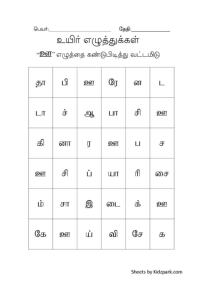

When ஊ uu is added to a consonant, a diacritic mark representing it is added to the end of the consonant, as in கூ kuu.When உ u is added to a consonant, a diacritic mark representing it is added to the bottom of the consonant, as in கு ku.When ஈ ii is added to a consonant, a diacritic mark representing it is added to the top of the consonant, as in கீ kii.When இ i is added to a consonant, a diacritic mark representing it is added to the end of the consonant, as in கி ki.When ஆ aa is added to a consonant, a diacritic mark representing it is added to the end of the consonant, as in கா kaa.Similar to many other South Asian scripts, Tamil consonants carry the inherent அ a sound, so அ a does not change when added to a consonant.(Long vowels are held about twice as long as short vowels.) In some cases, diacritic marks are added to the end of the consonants to represent vowels, but in others, marks are added to other locations. They alter their form depending on whether they are paired with a consonant and whether they are short or long vowels. The Tamil script has 12 vowels, which are written as independent letters when they appear at the beginning of a syllable. Unicode encodes the character in logical order (always the consonant first), whereas legacy 8-bit encodings (like TSCII) There are proponents of script reform who want to eliminate all ligatures and let all vowel signs appear on the right side. 'Code 2000' will show more ligatures than 'Latha'. See on this page depends on your font selection. These rules are evolving and older use has more ligatures than modern use. The diphthongs are usually pronounced about 1.5 times as long as the short vowels, though some grammatical texts place them with the long ('nedil') vowels.Īs can be seen in the compound form, the vowel sign can be added to the right, left or both sides of the consonants. The long ('nedil') vowels are about twice as long as the short ('kuRil') vowels. Special letter ஃ (pronounced 'akh') is rarely used by itself - normally serves purely grammatical function as independent vowel form of the dot on consonants that suppresses the inherent 'a' sound in plain consonants. letters that have both 'body' and 'soul'). Together with the consonants (which are called 'body' letters, they form compound, syllabic ( abugida) letters that are called 'living' letters (ie. Vowels are also called the 'life' or 'soul' letters. Of course, not all such words include these letters. The Tamil letters Basic Consonants Ĭonsonants are also called the 'body' letters.īorrowed consonants Īlso called Grantha letters, these are used exclusively for writing words borrowed from Sanskrit, English, and other languages. Some examples: a word cannot end in certain consonants, and cannot begin with some consonants including 'r' 'l' and 'll' there are two consonants for the dental 'n' - which one should be used depends on whether the 'n' occurs at the start of the word and on the letters around it. There are some lexical rules for formation of words. An overdot (see image) - equivalent to Devanagari sign virama - suppresses the inherent trailing a sound of the consonant sign - that is, it is a pure consonant. In every case the vowel symbol is different from the vowel standing alone. Some syllables are written by modifying the shape of the consonant in a way that is inherent to the vowel, others are written by adding vowel-inherent suffix to the consonant, yet others a prefix, and finally some vowels require adding both a prefix and a suffix to the consonant. However, the signs for the syllables are derived from that of the inherent consonant thus it is of the abugida type. The script is syllabic, in the sense that each letter is a syllable. This characterstic has partly to do with the fact that in ancient times, writing involved carving with a sharp point on palm leaves ( olaichuvadi) and it was apparently easier to produce curves than straight lines by this method. The script is sometimes called Vattezhuthu, literally "round writing". However, no such distinction is observed by modern Tamil speakers. Some scholars have suggested that in Sentamil (which refers to Tamil as it existed before Sanskrit words were borrowed), stops were voiceless when at the start of a word and unvoiced otherwise. Unlike Devanagari, Tamil has neither conjunct consonants nor aspirated and voiced stops. The consonants are classified into three categories with 6 in each category: vallinam - hard, mellinam - soft or nasal, and idayinam - medium. The vowels are divided into short and long (five of each type) and two dipthongs (ஐ and ஒள).

But one cannot of course use any consonant without suffixing it with vowel!) Their supporting argument is that when a consonant is used with a vowel it is a separate letter. (The practise of taking the cartesian product of the vowels and consonants is widely seen. The Tamil alphabet has 12 vowels and 18 consonants.


 0 kommentar(er)
0 kommentar(er)
